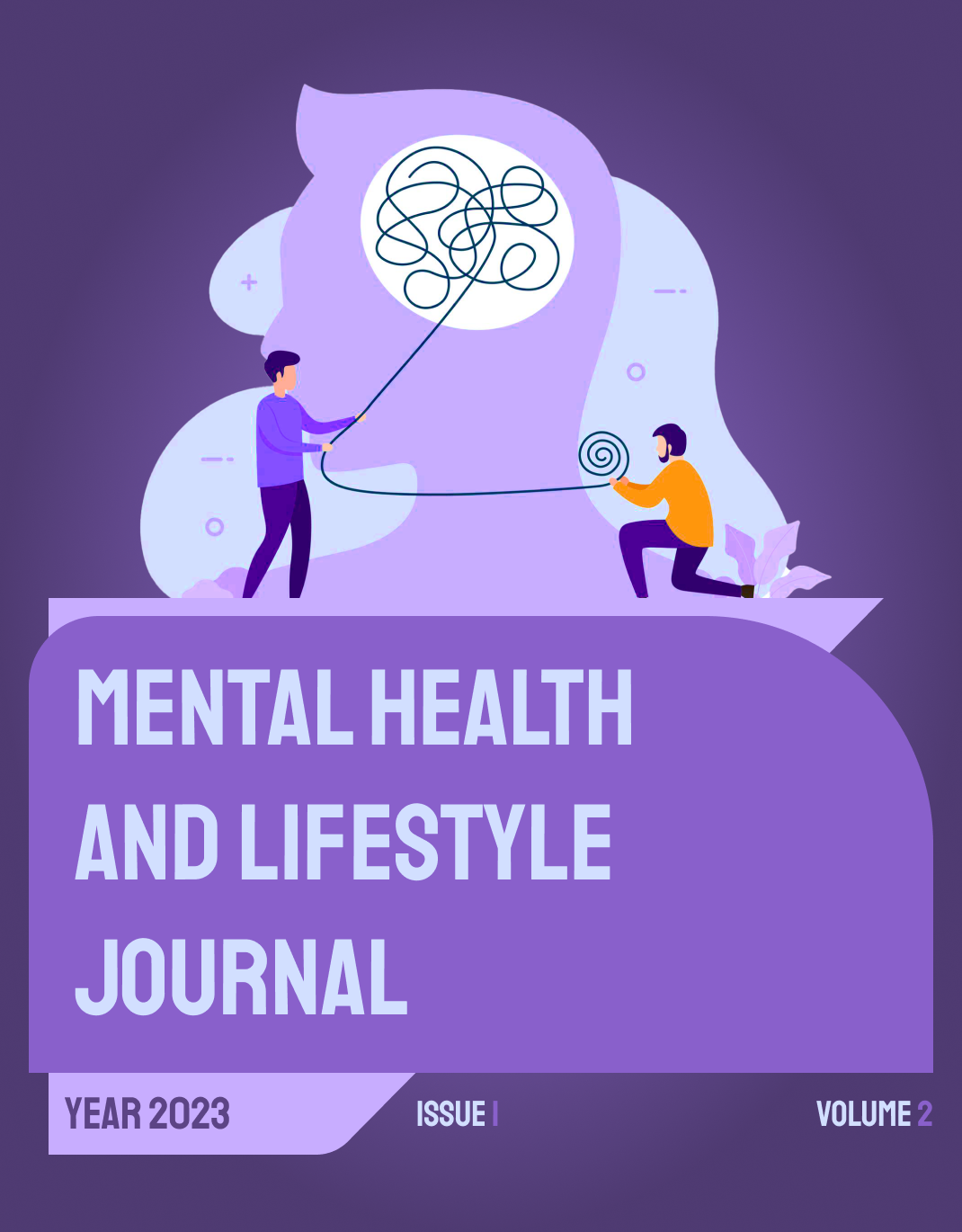Effects of Nutrition Habits and Sedentary Time on Psychological Distress in Adolescents
Keywords:
Adolescents, Psychological Distress, Nutrition Habits, Sedentary Time, Mental Health, Regression Analysis, Lifestyle FactorsAbstract
This study aimed to examine the predictive relationship between nutrition habits, sedentary time, and psychological distress in adolescents. A correlational descriptive study was conducted among 424 adolescents aged 12 to 18 years from secondary and high schools in Turkey. Participants were selected using stratified random sampling based on the Morgan and Krejcie sample size table. Data were collected using three standardized instruments: the Kessler Psychological Distress Scale (K10), the Adolescent Food Habits Checklist (AFHC), and the Adolescent Sedentary Activity Questionnaire (ASAQ). Statistical analyses were performed using SPSS version 27. Pearson correlation was used to assess bivariate associations between psychological distress and each independent variable, while multiple linear regression was conducted to examine the joint predictive value of nutrition habits and sedentary time on psychological distress. All assumptions for parametric tests were checked and confirmed. Pearson correlation analysis revealed a significant negative association between psychological distress and nutrition habits (r = -0.41, p < .01), and a significant positive association between psychological distress and sedentary time (r = 0.47, p < .01). Multiple regression analysis showed that the model was statistically significant (F(2, 421) = 86.48, p < .001), accounting for 30% of the variance in psychological distress (R² = .30, Adjusted R² = .29). Both nutrition habits (β = -0.33, t = -6.07, p < .001) and sedentary time (β = 0.39, t = 6.83, p < .001) were significant predictors. The findings suggest that poor nutrition habits and increased sedentary time are significant and independent predictors of psychological distress in adolescents. Interventions targeting healthier eating and reduced sedentary behavior may help mitigate mental health challenges in this age group.
Downloads
References
1. Monika M, Majeed J, Sharma N. Psychological Well-Being of Adolescents. JRTDD. 2023. doi: 10.53555/jrtdd.v6i7s.2157.
2. Chun SB, Lee M. The Relationship of Leisure-Time Sedentary Behavior, Physical Activity, and Generalized Anxiety Disorder Among Adolescents. Korean Soc Leisure Sci. 2023;14(1):225-34. doi: 10.37408/kjls.2023.14.1.225.
3. Guo Y, Yin X, Xu J, Chen F, Zhang F, Liu Y, et al. The Relationship Between Sedentary Behavior and Non-Suicidal Self-Injury Behavior Among Adolescents in China. Frontiers in Psychiatry. 2024;15. doi: 10.3389/fpsyt.2024.1489707.
4. Yoo H-N, Kim N. Factors Associated With Lifestyle Habits and Mental Health Problems in Korean Adolescents: The Korea National Health and Nutrition Examination Survey 2017–2018. International Journal of Environmental Research and Public Health. 2020;17(24):9418. doi: 10.3390/ijerph17249418.
5. Ula BM, Azizah N. Transforming Self-Esteem in Indonesian Teens by Overcoming Body Shaming. Ijhsm. 2024;1(1). doi: 10.21070/ijhsm.v1i1.8.
6. Zhang Y, Chen S, Wang C, Zhang X, Zou L, Chi X, et al. Does More Sedentary Time Associate With Higher Risks for Sleep Disorder Among Adolescents? A Pooled Analysis. Frontiers in Pediatrics. 2021;9. doi: 10.3389/fped.2021.603177.
7. You C, Cui Y. Examining the Hazards of Sedentary Behavior: An Overview of the Risks of Screen-Based Sedentary Behavior. Theoretical and Natural Science. 2024;29(1):226-36. doi: 10.54254/2753-8818/29/20240801.
8. Suk J. Combination of Sugar-Sweetened Beverage Consumption, Screen-Based Sedentary Time, and Sleep Duration and Their Association With South Korean Adolescents' Mental Health. Frontiers in Public Health. 2024;11. doi: 10.3389/fpubh.2023.1293505.
9. Santacruz E, Duarte-Zoilan D, Benítez G, Sequera G, Cañete F. Patterns of Physical Activity and Sedentary Behaviors in Adolescents Aged 13 to 15 in Paraguay. Anales De La Facultad De Ciencias Médicas (Asunción). 2021;54(3):17-24. doi: 10.18004/anales/2021.054.03.17.
10. Muniyappa RTM. The Role of Physical Fitness in Adolescent Mental Health. Ijcrt. 2024;14(4):50274-6. doi: 10.61359/2024050032.
11. Król D, Nowiński M, Mazurkiewicz W, Sak J, Fus-Mazurkiewicz L. Impact of Sedentary Behaviour on the Development of Diseases in Children and Adolescents – A Review of the Literature. Environmental Medicine. 2024;27(1):28-31. doi: 10.26444/ms/181517.
12. Adhikari B. Use of Screen Media and Mental Health: Effects on Adolescents and Pre-Adolescents. Journal of Nepal Medical Association. 2021;59(241):962-4. doi: 10.31729/jnma.5518.
13. Tebar WR, Canhin DS, Colognesi LA, Ana Elisa von Ah M, Silva DT, Christófaro DGD. Body Dissatisfaction and Its Association With Domains of Physical Activity and of Sedentary Behavior in a Sample of 15,632 Adolescents. International Journal of Adolescent Medicine and Health. 2020;33(6):539-46. doi: 10.1515/ijamh-2019-0241.
14. Werneck AO, Romanzini M, Silva DR, Oyeyemi AL, Bueno MR, Ronque ÊRV. Association of Mentally-Passive and Mentally-Active Sedentary Behaviors With Device-Measured Bouts and Breaks of Sedentary Time in Adolescents. Health Promotion Perspectives. 2021;11(1):109-14. doi: 10.34172/hpp.2021.14.
15. Zapata‐López JS, Tonguino‐Rosero S, Méndez F. Sedentary Behavior and School Bullying in Adolescents: An Analysis Based on a National Survey in Colombia. Journal of School Health. 2023;94(8):727-35. doi: 10.1111/josh.13397.
16. Yusuf RA, Syamsir MR, Silwanah AS. Kecanduan Gadget Dan Aktifitas Fisik Pada Remaja: Tinjauan Literatur. Media Ilmu Kesehatan. 2023;11(1):85-98. doi: 10.30989/mik.v11i1.651.
17. Opdal IM, Morseth B, Handegård B-H, Lillevoll K, Nilsen W, Nielsen CS, et al. Is Change in Mental Distress Among Adolescents Predicted by Sedentary Behaviour or Screen Time? Results From the Longitudinal Population Study the Tromsø Study: Fit Futures. BMJ Open. 2020;10(2):e035549. doi: 10.1136/bmjopen-2019-035549.
18. Wilhite K, Booker B, Huang BH, Antczak D, Corbett L, Parker PD, et al. Combinations of Physical Activity, Sedentary Behavior, and Sleep Duration and Their Associations With Physical, Psychological, and Educational Outcomes in Children and Adolescents: A Systematic Review. American Journal of Epidemiology. 2022;192(4):665-79. doi: 10.1093/aje/kwac212.
19. Fairclough SJ, Clifford L, Brown DMY, Tyler R. Characteristics of 24-Hour Movement Behaviours and Their Associations With Mental Health in Children and Adolescents. Journal of Activity Sedentary and Sleep Behaviors. 2023;2(1). doi: 10.1186/s44167-023-00021-9.
20. Nyberg G, Helgadóttir B, Kjellenberg K, Ekblom Ö. COVID-19 and Unfavorable Changes in Mental Health Unrelated to Changes in Physical Activity, Sedentary Time, and Health Behaviors Among Swedish Adolescents: A Longitudinal Study. Frontiers in Public Health. 2023;11. doi: 10.3389/fpubh.2023.1115789.
21. Logan NE, Ward‐Ritacco CL. The Developing Brain: Considering the Multifactorial Effects of Obesity, Physical Activity &Amp; Mental Wellbeing in Childhood and Adolescence. Children. 2022;9(12):1802. doi: 10.3390/children9121802.
22. Perrino T, Brincks AM, Estrada Y, Messiah S, Prado G. Reducing Screen-Based Sedentary Behavior Among Overweight and Obese Hispanic Adolescents Through a Family-Based Intervention. Journal of Physical Activity and Health. 2022;19(7):509-17. doi: 10.1123/jpah.2022-0050.
23. Argüelles DF, Sánchez‐Oliva D, Estrada JA, Fernández‐Río J. Longitudinal Associations Between Physical Activity and Mental Health in Adolescents. Ricyde Revista Internacional De Ciencias Del Deporte. 2023;19(71):16-28. doi: 10.5232/ricyde2023.07102.
24. Jee H. Physical Activity Trajectories of Different Grade Levels of Male Adolescents in Association of Academic Performance and Mental Health. Journal of Exercise Rehabilitation. 2023;19(5):258-67. doi: 10.12965/jer.2346352.176.
25. Lopes GCD. Screen, Brain and Behavior: Neuroscientific Evidence About the Negative Effects of Prolonged Use. South Florida Journal of Health. 2024;5(4):e4756. doi: 10.46981/sfjhv5n4-004.
26. Sampasa‐Kanyinga H, Colman I, Goldfield GS, Janssen I, Wang J, Podinic I, et al. Combinations of Physical Activity, Sedentary Time, and Sleep Duration and Their Associations With Depressive Symptoms and Other Mental Health Problems in Children and Adolescents: A Systematic Review. International Journal of Behavioral Nutrition and Physical Activity. 2020;17(1). doi: 10.1186/s12966-020-00976-x.
Downloads
Published
Submitted
Revised
Accepted
Issue
Section
License

This work is licensed under a Creative Commons Attribution-NonCommercial 4.0 International License.










